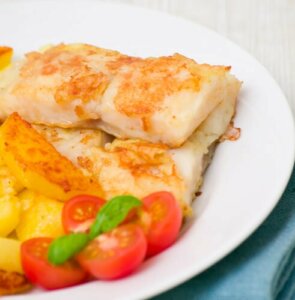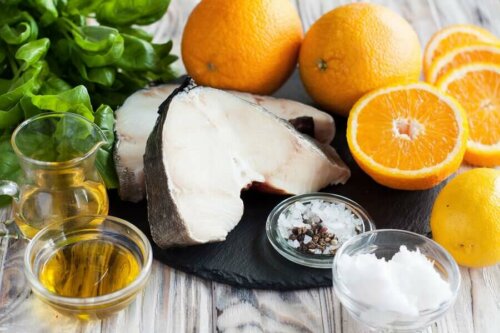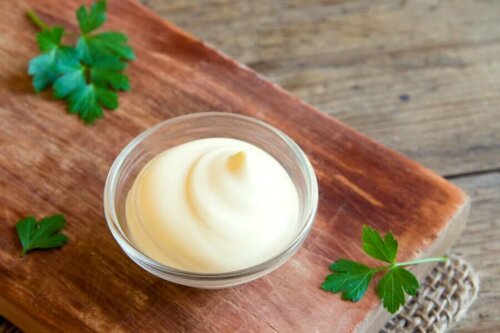Recipe for Cod Au Gratin with Mayonnaise


Written and verified by the nutritionist Marta Jiménez
Cod is a highly versatile fish and there are many ways to prepare it and today’s article contains a recipe to make it au gratin with mayonnaise. It’s equally simple, healthy, and tasty as this kind of fish has many proteins and essential nutrients.
Everyone should prioritize the consumption of fish instead of meat, even if it’s not a common practice yet. This is because seafood has a lower caloric content and may actually contain more nutritional properties than meat.
Cod, a fish to include in the diet
As we just said above, this fish has a wonderful nutritional composition. It has a low caloric content, only 78 calories per 3.5 ounces. Also, it’s low in fat and rich in omega 3 fatty acids.
The essential fats contained in cod are useful in modulating systemic inflammation; thus, they help reduce the risk of developing cardiovascular diseases. The need for its regular consumption is now well known despite the fact that fat has been demonized for many years.
The protein content exceeds that of other fish in the same group so it’s a good one to include in a weight loss diet or sports diet.
You must keep in mind that proteins are essential nutrients so you must include them in your daily diet. According to research published in the journal Advances in Nutrition, the intake of these substances shouldn’t be less than 0.01 ounces per kg bodyweight per day and you must increase it to 0.03-0.084 ounces if you exercise regularly.
Preparation of codfish au gratin with mayonnaise
Next, we’re going to give you a delicious cod recipe, loved by many.
Ingredients for 4 people
- 4 fresh cod loins (you can also use frozen or salted cod; the latter must be desalted by soaking it in water for two days and changing the water 2-3 times a day)
- 2.5 pounds of potatoes
- 2 ripe tomatoes
- 1 egg
- Extra virgin olive oil
- Salt
- Vinegar or lime or lemon

Make the mayonnaise
Cod au gratin with mayonnaise requires quality homemade mayo made with extra virgin olive oil. You may use sunflower oil, but olive oil has better nutritional properties.
Use extra virgin olive oil varieties such as arbequina or arbosana for a mild mayo flavor.
These are the steps to elaborate the homemade mayonnaise:
- Crack the egg in the bowl of a mixer and add the citrus or vinegar and salt
- Beat to a smooth mixture and add the extra virgin olive oil little by little so it emulsifies (do so without making upward and downward movements)
- Once you have an emulsion, beat by moving the mixer up-and-down
- Finally, set it aside until you’re ready to use it
Learn how to make Four Mayonnaise Recipes You’ll Love

Bake the cod au gratin with mayonnaise
- Firstly, preheat the oven to 350ºF. Then, peel and wash the potatoes and cut them into 1/4 inch slices.
- Add a tablespoon and a half of extra virgin olive oil to a baking dish and incorporate the potatoes and cook them — they take longer than the cod.
- Then, grate the tomatoes and add them to the cooked potatoes; then, place the cod loins on top.
- Bake the cod for 10-15 minutes; then it’s time to use the mayo.
- Pour it over the cod loins when these are ready.
- Turn on the grill of your oven and introduce the baking dish again.
- Bake it until it browns.
- Finally, remove the dish from the oven and serve.
Read about Omega-3-Rich Fish You Should Start Eating
Cod au gratin can improve the quality of your diet
This dish is a great way to include fish in your diet but don’t limit yourself to it. There are many ways to make seafood. This meal will surely trigger your every sense so check it out and definitely introduce more fish into your daily diet.
All cited sources were thoroughly reviewed by our team to ensure their quality, reliability, currency, and validity. The bibliography of this article was considered reliable and of academic or scientific accuracy.
- Watanabe Y., Tatsuno I., Omega 3 polyunsaturated fatty acids for cardiovascular diseases: present, past and future. Expert Rev Clin Pharmacol, 2017. 10 (8): 865-873.
- Wolfe RR., Ciflli AM., Kostas G., Kim IY., Optimizing protein intake in adults: interpretation and application of the recommended dietary allowance compared with the acceptable macronutrient distribution range. Adv Nutr, 2017. 8 (2): 266-275.
This text is provided for informational purposes only and does not replace consultation with a professional. If in doubt, consult your specialist.








